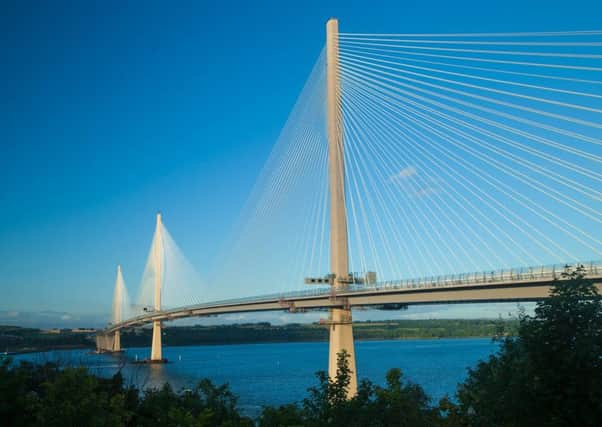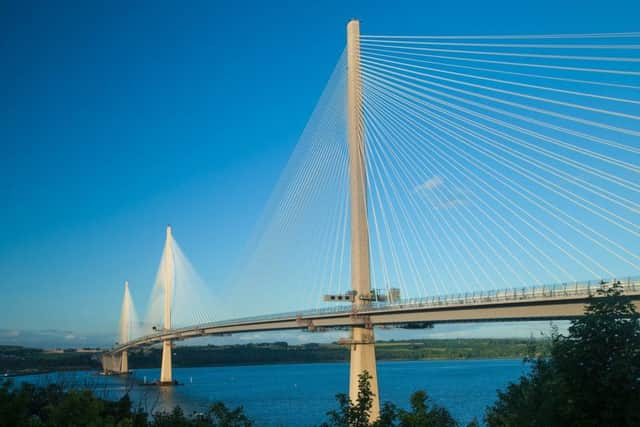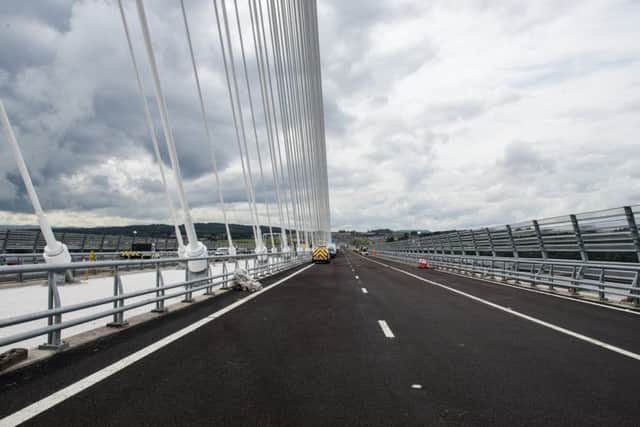Terror barriers to protect walkers on Queensferry Crossing


The news comes as final preparations are made to open the £1.35 billion replacement for the Forth Road Bridge on Wednesday.
Scotland on Sunday can also reveal that a third lane could be brought into use on the crossing to tackle congestion.
Advertisement
Hide AdAdvertisement
Hide AdThe bridge will close again early on Friday for the installation of barriers for the bridge walks.


Tight security will be in place for the events, in which 50,000 people, chosen from 226,000 entries, are due to cross on Saturday and Sunday. They will be followed by 6,500 bridge workers and their families on Sunday evening and 10,000 local school pupils and residents two days later.
Walkers taking the 1.7-mile stroll will also have to wear security passes containing their photograph and must bring passports or other ID, while bags will be searched.
The Scottish Government’s Transport Scotland agency said: “In the current state of heightened security, appropriate measures are being taken by the project, in collaboration with the relevant authorities, to ensure the safety of all participants involved in the opening events.”
The Queen will mark the bridge’s opening in ceremonies at either end on Monday, 4 September – 53 years to the day after she opened its neighbour.


Accompanied by the Duke of Edinburgh, who is due to make one of his occasional returns to public engagements, she is expected to cut a ribbon and unveil a plaque on the Edinburgh side before being driven across the bridge to unveil another plaque at the Fife end.
The Queensferry Crossing will not re-open until 7 September after removal of the barriers.
The unusual opening timetable is partly so the Scottish Government can save face, enabling economy secretary Keith Brown to honour the mid-July to end of August date range he gave MSPs in March.
Advertisement
Hide AdAdvertisement
Hide AdHe had already announced a delay from the original December opening to May because of bad weather.


Brown described the completion of the project six years after construction started as “a remarkable achievement for a project of this scale and complexity”.
He said: “The challenges of this location have been well-documented and the real heroes are those who have braved the elements in sometimes horrendous conditions to finish the job.”
Poor conditions, mainly strong winds, have added some 35 per cent to the time taken to complete the scheme compared with the anticipated 25 per cent extra.
They have added to the challenge of the project, with Queensferry Crossing technical director Mike Glover paying tribute to the courage of the workforce, which has totalled more than 15,000 since 2011.


They have broken records, such as with a carriageway section that stretched for nearly half a mile at the central tower before being joined up. Concrete was poured round-the-clock for 15 days into the underwater foundations (caisson) of the south tower, which is the height of the Statue of Liberty.
“These set the crossing apart from even the Millau Viaduct in France [the world’s tallest bridge] – its foundations were in the ground, not under the water,” said Glover.
The Forth Crossing Bridge Constructors consortium will have to pay all over-run costs.
Advertisement
Hide AdAdvertisement
Hide AdThe bridge’s speed limit will be 40mph – as on its neighbour – but increased to 70mph when it becomes part of the M90 motorway, by early November. The gap is for new road links to be completed to enable buses and taxis to use the older bridge, which will become a “public transport corridor”. Pedestrians and cyclists will continue to use their segregated paths on that bridge.
The Queensferry Crossing’s hard shoulder – which the older bridge doesn’t have – will be used for breakdowns, and for buses when the latter is closed in high winds. However, they are wider than normal to provide a third vehicle lane if required.
A Transport Scotland spokesman said: “Future options which might be considered are to allow bus hard shoulder running similar to that to the north and south of the crossing currently, or to have a ‘high occupancy vehicle’ lane, as is often done in other countries to try to reduce the overall number of vehicles by encouraging car-sharing.”
Motoring group IAM RoadSmart’s policy and research director Neil Greig said: “All too often, new infrastructure becomes congested far before the time anticipated because extra flexibility has not been built in. So it’s good news this has been done on the new bridge, opening up the possibility for ‘smart’ motorways or other congestion-busting approaches in the future.”
Windshielding on the bridge – which the older bridge also doesn’t have – means it should virtually never have to close.
Glover said: “If you can get to the bridge, you will be able to cross it.” He said the chance of a lorry being blown over while crossing was “very remote”.
He said the 11ft-high shielding worked by directing winds over the carriageways and through its gaps, which also give drivers a view. It will also “substantially” reduce traffic noise for residents.
LED lighting along the outside of the carriageways promises a dramatic night-time spectacle, but is not expected to be ready until after the opening. There will also be low-key lighting around its towers and on approach viaducts.
Advertisement
Hide AdAdvertisement
Hide AdThe opening will be followed by the launch of a Forth Bridges Tourism Strategy which Transport Scotland said “will seek to tap into the three bridges as a unique setting and world-leading visitor destination”. This is expected to include a new visitor centre.
New coat of paint not required until 2047
The opening of the Queensferry Crossing will not coin a new phrase because it is not expected to have to be painted for 30 years.
The supposedly endless task of “Painting the Forth Bridge” was banished by Network Rail in 2011 with the completion of a new 30-year coating.
The Queensferry Crossing, 127 years younger, has matched that first time around, with its first touch-up also not expected for that long.
However, engineers plan to carry out the first full inspection of the bridge in five to seven years time.
Like the Forth Road Bridge, the crossing has a 120-year design life – although its mechanically troubled elder neighbour has only reached 53.
Improvements include the support cables on what is the world’s longest three-tower cable-stayed bridge being individually replaceable.
Replacing the FRB’s main cable would be difficult without closing the bridge.
Advertisement
Hide AdAdvertisement
Hide AdIn 2004, corrosion found inside its 2ft thick cable, which runs the length of the bridge, led to the new crossing being ordered because of concerns about the FRB’s life expectancy. The expansion joints at either end of the new bridge’s carriageways, expected to last 50 years, can be repaired in sections to minimise traffic disruption.
Such is the scale of the work in replacing the FRB’s original expansion joints that it was postponed eight years ago until the Queensferry Crossing opened.
Rail bridge painting was popularly seen as an endless task
Timeline: From corrosion to completion
2005: Following inquiries by The Scotsman, Scottish Government ministers announce Forth Road Bridge corrosion is so bad that lorries might have to be banned in eight years.
2006: Ministers decide to replace the bridge because of corrosion fears.
2007: Cable-stayed bridge announced as “Forth Replacement Crossing”.
2008: Design and other preparatory work starts.
2009: Forth Crossing Bill introduced to Scottish Parliament.
2010: Bill passed.
2011: Construction starts by Forth Crossing Bridge Constructors consortium.
2012: Upgraded M9 Junction 1a completed.
June 2013: Queensferry Crossing announced as name after 35,000 votes cast in public vote.
September 2013: Tower foundations completed.
May 2014: Steel deck sections start to arrive in Rosyth.
Autumn 2015: Tower construction completed.
April 2016: Fitter John Cousins, 60,
died after being reportedly struck
by the boom of a
Advertisement
Hide AdAdvertisement
Hide Adcrane on the north tower deck. Construction halted for three days as a mark of respect.
June 2016: Bridge opening delayed from December to May 2017 because of bad weather.
August 2016: North tower joined to Fife shore.
October 2016: All three towers joined to Fife shore.
February 2017: Last deck section lifted into place, completing carriageway across Forth.
March 2017: Opening further delayed by weather problems, from May until between mid-July and the end of August.
30 August: Bridge due to open to traffic.